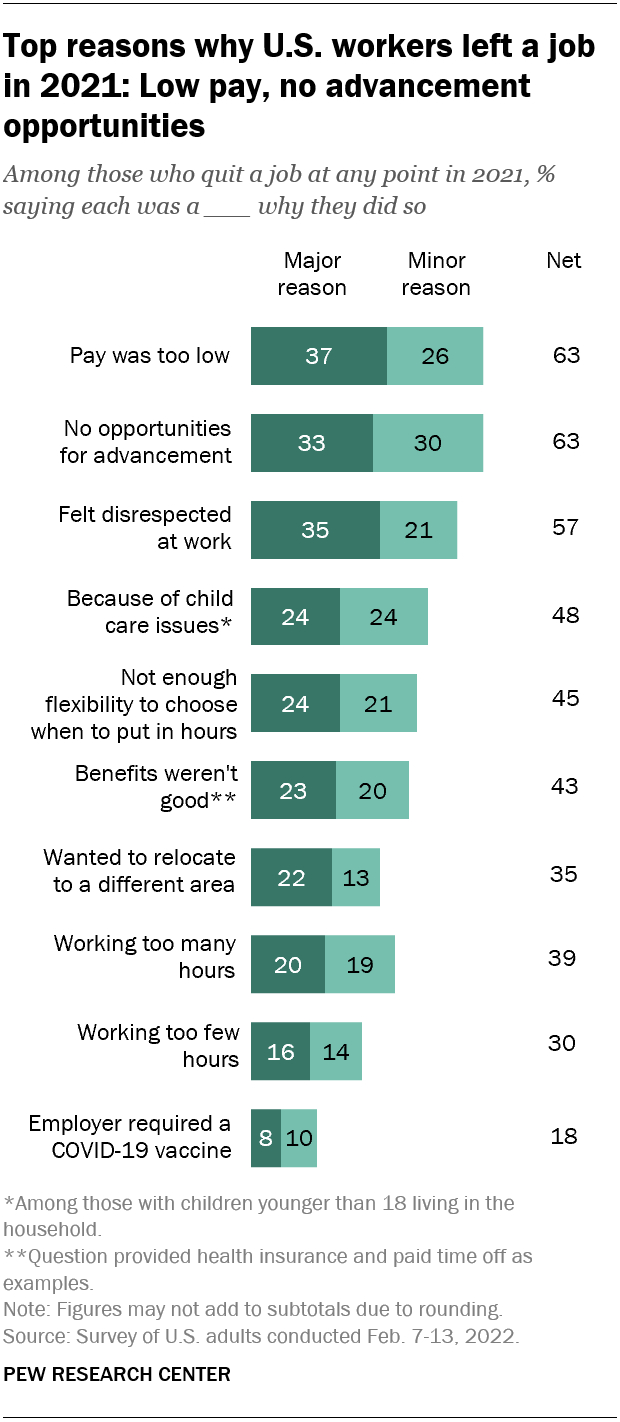The Great Resignation has recently become a buzzword, along with Covid, pandemic, and work from home. But while the pandemic is over, the Great Resignation isn’t. In 2021, 48 million people left their jobs, while 41% of the global workforce now considers doing the same. These figures seem shocking, especially given the fact that only two years ago, when the pandemic outbreak began, those who didn’t lose their job were more than grateful for having it.
So, what are the reasons behind people massively fleeing from their workplaces in 2022, and what businesses can do about it? Are there any practices to attract and retain good employees? In this article, we will take an up-to-date look at distributed team management, keeping the Great Resignation trends in mind.
Need a ready-made solution to hire amid the Great Resignation? Ask our recruitment experts now!
Main reasons for a reshuffle – why people massively quit their jobs
So, what makes people quit their jobs? According to the Pew Research Center study, the main reasons are low salary, no career opportunities and feeling disrespected at work. Other reasons refer to childcare issues, a non-flexible schedule, overworking and even the employer’s requirement to get a Covid vaccine.

Well, any of the reasons cited above can be solid enough to quit a job, but they are still pretty general and don’t take the specifics of the industry into account. At the same time, healthcare and ICT (Information and Communication Technologies) are the industries with the highest resignation rates.
So, why do tech workers resign?
72% of tech workers are thinking of quitting their job or exploring other job opportunities in the next 12 months. The problem of tech talent reshuffling is so massive that in response to it, Apple shot a humorous video, telling a story of tech workers deciding to quit because they haven’t enough time for lunch and their boss never remembered their names.
Indeed, the reasons in the video are worth a laugh and seem like being pulled from thin air. In the real world, tech workers quit their jobs on more serious grounds. Here is what modern developers want in exchange for their programming talent, time and commitment.
- They want a job that will not affect their well-being. Ineffective project management, lack of proper planning and the necessity to overwork are the main reasons why tech minds decide to look for a new opportunity and get a better work-life balance.
- They want more transparency, collaboration and empathy. A toxic environment at work is another frequent reason mentioned by those decided to quit a job. Modern tech talent, especially their younger generation, want more transparency between executives and ordinary employees; they want their opinions to be appreciated and their necessities to be taken into account.
- They would like to make an impact and have a meaningful job. Some tech workers intentionally abandon their prestigious and high-paying jobs in globally leading companies with the goal of switching to a job with a more significant and world-changing potential.
- They prioritize flexible job opportunities. While 16% of companies globally are already fully remote, some businesses still require their employees to stay in the office working nine to five. This is just the requirement the majority of tech workers are likely to avoid in pursuit of more flexibility and result-orientedness.
So, Great Resignation made hiring tech talent even more challenging. The best-skilled programming minds have long recognized their value that can’t be measured with money only. Plus, there is a significant tech talent shortage, so rethinking your approaches to hiring software developers and software project management is the only way to adjust to the challenges triggered by the Great Resignation.
Building a remote and distributed team can be an option. Let’s find out how to do it in the most effective way.
Overcoming the Great Reshuffle – how to attract top tech talent and retain them
The new norm looks as follows. The best programming specialists no longer want to work just for money and spend meaningless hours in the office. However, there are no changes and challenges without opportunities, so now is the right time to start working with distributed teams. Let’s do it together step by step.
Accept that remote hiring and building distributed teams are a new norm
Remote work was here long before the Covid outbreak. The recent pandemic just triggered its larger adoption, promising more cost-efficiency for companies and better productivity for employees. And vice versa – those companies insisting on an only-office work mode will gradually lose the best talent.
In spite of these changes, the first thing is to accept that remote work will be the way everyone works in ten years maximum. Next, change your business operations step by step. For example, get started by taking a look at our article on how to hire top remote talent.
Leverage proactive sourcing
A massive switch to remote work opens more opportunities for global hiring. While the companies can now choose from the global talent pool, the best candidates can choose from the global list of companies too. That’s why you have to source candidates proactively to reach out to the best tech minds.
What Is Candidate Sourcing and Why It Needs to Be Part of Your Tech Talent Acquisition Strategy
Proactive talent sourcing is one of the best practices to hire distributed workforce since it allows for gathering a pool of potentially suitable candidates and closing both current and future positions faster and cheaper.
Do you want to get the best-matched candidates in a few days? Let our recruitment experts help you!
Focus on skills match more than on a cultural fit
A cultural fit has long been considered important in distributed teams. Indeed, this approach is pretty-grounded – people with the same cultural backgrounds understand each other better than those with a mentality gap. On the other hand, cultural diversity can be an advantage as well, since people from different cultures tend to solve problems differently.
So, strive for a balance when gathering a distributed team. A successful distributed team is one with both cultural similarities and differences, while the skill set fit is more important than the cultural one.
Ensure business hours overlap
In most cases, distributed teams have to work out of time zones so you have to set up a workflow with the time differences in mind. There are some of the best practices to follow:
- Ensure that all team members have at least two business hours overlap. This time frame is enough to communicate on the most urgent issues, and take part in daily/weekly meetings.
- Try to hire related specialists from the same time zones. For example, if your project needs two designers, it would be better if they can collaborate all the time.
Choose use-case-tailored task management and communication tools
After you have aligned time zones, choose the right distributed team collaboration tools, being guided by the specifics of your project and team size.
For example, simple tools like Trello or Basecamp are best-suited for small-to-medium projects developed according to the Waterfall methodology. For large projects that need more task management features, the opportunity to manage multiple workflows from a single platform and create tasks automatically, ClickUp can be a better option. As for communication tools, most companies use Slack for texting, and Google Meet or Zoom for video conferencing.
Allow a flexible schedule, but still track the progress and performance
One of the main benefits of distributed teams is that they are fully remote. However, remote work and flexible work aren’t the same things, but rather a combination most tech workers consider essential. So, allow your distributed team to work flexibly, but still keep the time zone differences in mind.
One of the best practices for distributed team management and collaboration is setting fixed time frames for when the team members should start and finish their work. Also, make sure to track their progress and productivity. Most task management tools allow for logging work time per task and per day, and when integrated with accounting software, they make payroll easier too.
Develop and establish clear communication practices
17% of remote workers say communication is one of the biggest challenges they face. For businesses, a lack of well-established communication practices also leads to failed deadlines, less effective collaboration and more mistakes. That’s why you have to develop and establish clear communication practices for the distributed team to follow.
Planning daily and weekly meetings so that the team can discuss the current and planned tasks, ask questions and update each other on their progress statuses is one of the most common approaches. In some teams, there are also strict response times – for example, any team member should respond to a message or email within twenty or fewer minutes.
Also, to make remote collaboration and communication effective, the iteration cycles between core team members should be short. For example, designers, developers and testers should have the opportunity to frequently stay in touch, ensuring continuous project delivery.
Leverage remote team-building opportunities
Team building is important for both in-office and distributed teams’ success. What’s more, there are a lot of opportunities for making your distributed developers feel like a part of a great team. For example, some companies schedule weekly meetings just to let the team members talk about anything they want and create an atmosphere of real-life conversations taking place during the coffee breaks. There is also a practice of sending branded gifts and even launching online parties.
Hire great tech talent despite the Great Resignation
The Great Resignation created additional challenges in hiring the best-skilled professionals, especially in the tech sector. You have to not only hire the right people but also double your efforts to retain them. However, there is also good news. Despite tech and non-tech workers quitting their jobs massively, most start looking for a new opportunity right after resigning or even before it.
The only remaining task is to catch them at the right moment. Bridge talent sourcers would be happy to help you with reaching out to the best-skilled and motivated employees who are serious about landing a new project.
Consider our sourcing-as-a-service to reach out to the candidates in the search for a job opportunity five times faster than looking for them on your own. Our tech-enabled talent sourcing engine comes with advanced data gathering and analysis features, allowing us to select the finest-tuned candidates using semantic search and multiple data filters. Being 80% automated, our AI-driven algorithm allows for saving up to 60% of the hiring budget, unlocking the global tech talent pool in an instant.
Try out the talent sourcing engine in action now to quickly hire the best candidates despite the labor market challenges!



